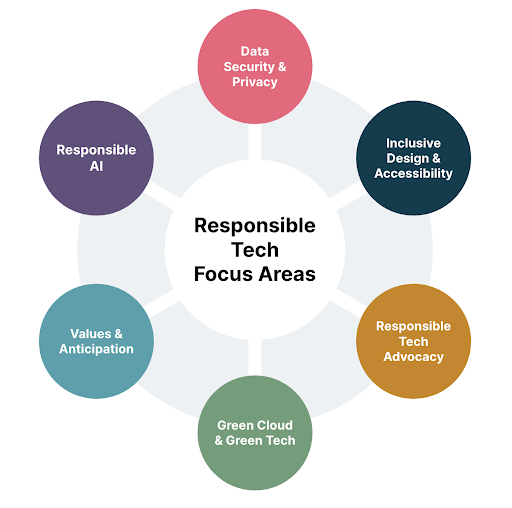The myth of technology being inherently neutral or objective is finally being debunked across many organizations. Consequently, business leaders are starting to recognize just how important it is for their teams to realize the impact of their technology decisions and solutions. The state of responsible tech report shows us that 73% of business leaders recognise that responsible tech concerns are on the rise and need to be considered alongside business and financial considerations. However, once an organization realizes that our technology choices will have an impact on our users and society as a whole, where do we even start to begin our responsible tech journey?
Like other forms of digital transformation we can break the journey down into phases:
Awareness. This is where the organization starts to recognize that responsible tech choices matter and that action needs to be taken.
Reflection. In this phase, organizations will undergo a re-evaluation of their core values and principles to power ethical decision making going forward.
Empowerment. Following that period of re-evaluation, the next phase involves enabling people within the organization to act on those new core values via responsible tech tools and methodologies.
Experimentation. This phase allows teams who have begun embedding said tools in their teams delivery processes to analyze and modify tools for their specific workflows.
Optimization. In this phase, responsible tech tools and methodologies should be seen as sensible defaults, but will be refined and evolved over time and as new challenges emerge.
Those steps make the journey towards becoming a responsible tech organization sound straightforward. However, the process can be challenging and will require a sense of purpose, careful coordination and thoughtfulness to be achieved successfully. To do that, it’s worth digging into each of those phases in more depth.
Awareness
During the awareness phase it’s essential that organizations realize that there are several organizational challenges ahead. Organizations tend to be resistant to change and the more processes you have within your organization the higher potential for resistance.
Often competing priorities and mismatched mandates between teams is the primary source. As the main drivers of prioritization and decision making, buy-in from senior leadership is essential. This means it’s important that everyone is aware of the value responsible tech practices will provide teams and the organization, whether it’s attracting and retaining top talent or building trust and brand equity with users. Without collective ownership it will be challenging to progress to the next phase.
Reflection
The reflection phase can be the most difficult as organizations need to assess their past, present and future. The list of questions an organization should ask about itself will typically be specific to its context — and potentially endless. However, there are some that are particularly common:
To what extent is our current workforce diverse and inclusive?
What products and services will have the largest impact on society and the environment?
What ethical nightmares should we prepare for and have a clear response to?
Where might we have blind spots?

This phase could also be viewed as a type of discovery, not unlike one you’d do at the start of a design or development project; it’s crucial in helping the organization establish a responsible mindset. Because responsible tech is quite a broad term, answering these questions can assist you in deciding what to prioritize and focus on. For example, teams that are heavily leveraging AI and machine learning should focus on combating bias, while an organization with a particularly large carbon footprint should focus on sustainability.
The things you uncover through this process of reflection are key to the next phases. For example, reflecting on your values and anticipating unintended consequences can help you across a variety of areas such as responsible AI, data security and privacy. Creating a diverse and inclusive workforce can also better inform how you approach inclusive design and accessibility. Concentrating on critical areas and embracing the overlap of approaches and skills in these areas will assist with expanding your capabilities.
Empowerment
People need to be empowered to start adopting responsible tech best practices available to them. The responsible tech playbook is one resource that can help with this; it offers a framework for exploring and evaluating certain tools and methodologies during the reflection phase. Consequence Scanning can allow teams to start analyzing both the intended and unintended consequences of their products and services. Security concerned organizations should adopt agile threat modeling shifting security concerns earlier in development. AI and machine learning teams should focus on explainable AI — tools such as InterpretML can help people understand the outputs of their models.
Most organizations focused on sustainability are adopting green cloud optimization as a methodology. These tools shift responsibility and safety to the left — where other technical and design decisions are happening — ensuring that those considerations aren’t overlooked or treated as a necessary add-on at the end of a process. When people are empowered, the processes, incentives and measurements around responsible tech can effectively accelerate adoption.
Experimentation
The selection and application of tools is always a process of deliberation. It requires analysis and experimentation. There are many ways this can be done — sometimes evaluation and measurement can be done quantitatively, sometimes qualitatively. You may also need to experiment with organizational and communication structures. The key during this phase is to learn from experience and to improve upon the tools both internally and externally by sharing stories of success and failure.
Get started and be iterative in your approach
Depending on the organization, each phase of the journey will look different. However, the key here is that every organization that leverages technology extensively needs to begin that journey. It requires will and commitment. Moreover, understanding that this is an organizational transformation and that it will continue to be an iterative process — as technology and responsible best practices continue to evolve — is essential to success.


















